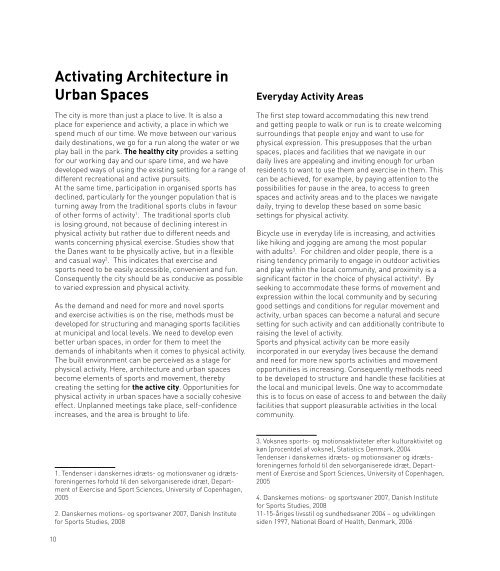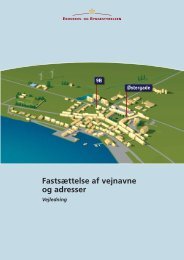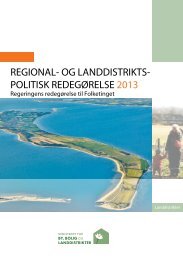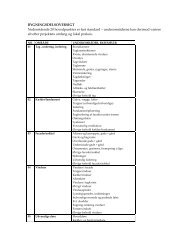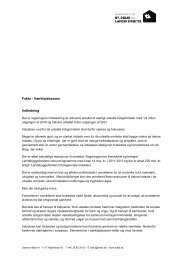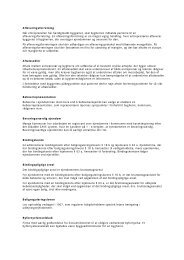Activating Architecture in Urban Spaces
Activating Architecture in Urban Spaces
Activating Architecture in Urban Spaces
Create successful ePaper yourself
Turn your PDF publications into a flip-book with our unique Google optimized e-Paper software.
10<br />
<strong>Activat<strong>in</strong>g</strong> <strong>Architecture</strong> <strong>in</strong><br />
<strong>Urban</strong> <strong>Spaces</strong><br />
The city is more than just a place to live. It is also a<br />
place for experience and activity, a place <strong>in</strong> which we<br />
spend much of our time. We move between our various<br />
daily dest<strong>in</strong>ations, we go for a run along the water or we<br />
play ball <strong>in</strong> the park. The healthy city provides a sett<strong>in</strong>g<br />
for our work<strong>in</strong>g day and our spare time, and we have<br />
developed ways of us<strong>in</strong>g the exist<strong>in</strong>g sett<strong>in</strong>g for a range of<br />
different recreational and active pursuits.<br />
At the same time, participation <strong>in</strong> organised sports has<br />
decl<strong>in</strong>ed, particularly for the younger population that is<br />
turn<strong>in</strong>g away from the traditional sports clubs <strong>in</strong> favour<br />
of other forms of activity 1 . The traditional sports club<br />
is los<strong>in</strong>g ground, not because of decl<strong>in</strong><strong>in</strong>g <strong>in</strong>terest <strong>in</strong><br />
physical activity but rather due to different needs and<br />
wants concern<strong>in</strong>g physical exercise. Studies show that<br />
the Danes want to be physically active, but <strong>in</strong> a flexible<br />
and casual way 2 . This <strong>in</strong>dicates that exercise and<br />
sports need to be easily accessible, convenient and fun.<br />
Consequently the city should be as conducive as possible<br />
to varied expression and physical activity.<br />
As the demand and need for more and novel sports<br />
and exercise activities is on the rise, methods must be<br />
developed for structur<strong>in</strong>g and manag<strong>in</strong>g sports facilities<br />
at municipal and local levels. We need to develop even<br />
better urban spaces, <strong>in</strong> order for them to meet the<br />
demands of <strong>in</strong>habitants when it comes to physical activity.<br />
The built environment can be perceived as a stage for<br />
physical activity. Here, architecture and urban spaces<br />
become elements of sports and movement, thereby<br />
creat<strong>in</strong>g the sett<strong>in</strong>g for the active city. Opportunities for<br />
physical activity <strong>in</strong> urban spaces have a socially cohesive<br />
effect. Unplanned meet<strong>in</strong>gs take place, self-confidence<br />
<strong>in</strong>creases, and the area is brought to life.<br />
1. Tendenser i danskernes idræts- og motionsvaner og idrætsforen<strong>in</strong>gernes<br />
forhold til den selvorganiserede idræt, Department<br />
of Exercise and Sport Sciences, University of Copenhagen,<br />
2005<br />
2. Danskernes motions- og sportsvaner 2007, Danish Institute<br />
for Sports Studies, 2008<br />
Everyday Activity Areas<br />
The first step toward accommodat<strong>in</strong>g this new trend<br />
and gett<strong>in</strong>g people to walk or run is to create welcom<strong>in</strong>g<br />
surround<strong>in</strong>gs that people enjoy and want to use for<br />
physical expression. This presupposes that the urban<br />
spaces, places and facilities that we navigate <strong>in</strong> our<br />
daily lives are appeal<strong>in</strong>g and <strong>in</strong>vit<strong>in</strong>g enough for urban<br />
residents to want to use them and exercise <strong>in</strong> them. This<br />
can be achieved, for example, by pay<strong>in</strong>g attention to the<br />
possibilities for pause <strong>in</strong> the area, to access to green<br />
spaces and activity areas and to the places we navigate<br />
daily, try<strong>in</strong>g to develop these based on some basic<br />
sett<strong>in</strong>gs for physical activity.<br />
Bicycle use <strong>in</strong> everyday life is <strong>in</strong>creas<strong>in</strong>g, and activities<br />
like hik<strong>in</strong>g and jogg<strong>in</strong>g are among the most popular<br />
with adults 3 . For children and older people, there is a<br />
ris<strong>in</strong>g tendency primarily to engage <strong>in</strong> outdoor activities<br />
and play with<strong>in</strong> the local community, and proximity is a<br />
significant factor <strong>in</strong> the choice of physical activity 4 . By<br />
seek<strong>in</strong>g to accommodate these forms of movement and<br />
expression with<strong>in</strong> the local community and by secur<strong>in</strong>g<br />
good sett<strong>in</strong>gs and conditions for regular movement and<br />
activity, urban spaces can become a natural and secure<br />
sett<strong>in</strong>g for such activity and can additionally contribute to<br />
rais<strong>in</strong>g the level of activity.<br />
Sports and physical activity can be more easily<br />
<strong>in</strong>corporated <strong>in</strong> our everyday lives because the demand<br />
and need for more new sports activities and movement<br />
opportunities is <strong>in</strong>creas<strong>in</strong>g. Consequently methods need<br />
to be developed to structure and handle these facilities at<br />
the local and municipal levels. One way to accommodate<br />
this is to focus on ease of access to and between the daily<br />
facilities that support pleasurable activities <strong>in</strong> the local<br />
community.<br />
3. Voksnes sports- og motionsaktiviteter efter kulturaktivitet og<br />
køn (procentdel af voksne), Statistics Denmark, 2004<br />
Tendenser i danskernes idræts- og motionsvaner og idrætsforen<strong>in</strong>gernes<br />
forhold til den selvorganiserede idræt, Department<br />
of Exercise and Sport Sciences, University of Copenhagen,<br />
2005<br />
4. Danskernes motions- og sportsvaner 2007, Danish Institute<br />
for Sports Studies, 2008<br />
11-15-åriges livsstil og sundhedsvaner 2004 – og udvikl<strong>in</strong>gen<br />
siden 1997, National Board of Health, Denmark, 2006


